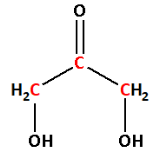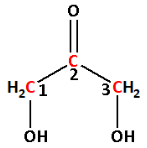
Select correct IUPAC naming of given compound.

(A) Propanone-1,3-diol
(B) 1,3-dihydroxy propanal
(C) 1,3-dihydroxypropanone
(D) Propanediol

Answer
553.5k+ views
Hint:The method of naming organic compounds is known as the IUPAC nomenclature. In the given structure, two hydroxyl i.e. alcoholic groups are attached as substituents. Also, there is one carbonyl i.e. ketonic group present.
Complete step-by-step solution:The given structure with all of its atoms is as follows:

Select the longest continuous chain of carbon atoms in the structure of the molecule.

Number the carbon atoms in the selected carbon chain from the end which is nearest to the hydroxyl substituents. But the hydroxyl substituents are attached to both the ends. Thus, we can name the carbon atoms from any side.

The longest chain contains three carbon atoms. Thus, the parent alkane is propane. And one ketonic group is attached to carbon number-2.Thus, propanone.
The two hydroxyl groups are attached to carbon number -1 and carbon number- 3. Thus, 1,3-dihydroxy.
Thus, the IUPAC name is 1,3-dihydroxypropanone.
Thus, the correct option is (C) 1,3-dihydroxypropanone.
Thus, the correct option is (C) 1,3-dihydroxypropane.
Note:The rules for writing IUPAC name of compounds are as follows:
1. Select the longest continuous chain of carbon atoms in the structure of the molecule.
2. Number the carbon atoms in the selected carbon chain from the end which is nearest to the substituents attached.
3. Count the number of carbon atoms in the chain. This is the parent alkane.
4. Write the number indicating the position of the substituents.
5. Assign a number to each substituent according to the carbon atom it is attached. If there are two substituents on the same carbon, assign the same number to them.
Complete step-by-step solution:The given structure with all of its atoms is as follows:

Select the longest continuous chain of carbon atoms in the structure of the molecule.

Number the carbon atoms in the selected carbon chain from the end which is nearest to the hydroxyl substituents. But the hydroxyl substituents are attached to both the ends. Thus, we can name the carbon atoms from any side.

The longest chain contains three carbon atoms. Thus, the parent alkane is propane. And one ketonic group is attached to carbon number-2.Thus, propanone.
The two hydroxyl groups are attached to carbon number -1 and carbon number- 3. Thus, 1,3-dihydroxy.
Thus, the IUPAC name is 1,3-dihydroxypropanone.
Thus, the correct option is (C) 1,3-dihydroxypropanone.
Thus, the correct option is (C) 1,3-dihydroxypropane.
Note:The rules for writing IUPAC name of compounds are as follows:
1. Select the longest continuous chain of carbon atoms in the structure of the molecule.
2. Number the carbon atoms in the selected carbon chain from the end which is nearest to the substituents attached.
3. Count the number of carbon atoms in the chain. This is the parent alkane.
4. Write the number indicating the position of the substituents.
5. Assign a number to each substituent according to the carbon atom it is attached. If there are two substituents on the same carbon, assign the same number to them.
Recently Updated Pages
Why are manures considered better than fertilizers class 11 biology CBSE

Find the coordinates of the midpoint of the line segment class 11 maths CBSE

Distinguish between static friction limiting friction class 11 physics CBSE

The Chairman of the constituent Assembly was A Jawaharlal class 11 social science CBSE

The first National Commission on Labour NCL submitted class 11 social science CBSE

Number of all subshell of n + l 7 is A 4 B 5 C 6 D class 11 chemistry CBSE

Trending doubts
What is meant by exothermic and endothermic reactions class 11 chemistry CBSE

10 examples of friction in our daily life

One Metric ton is equal to kg A 10000 B 1000 C 100 class 11 physics CBSE

1 Quintal is equal to a 110 kg b 10 kg c 100kg d 1000 class 11 physics CBSE

Difference Between Prokaryotic Cells and Eukaryotic Cells

What are Quantum numbers Explain the quantum number class 11 chemistry CBSE




